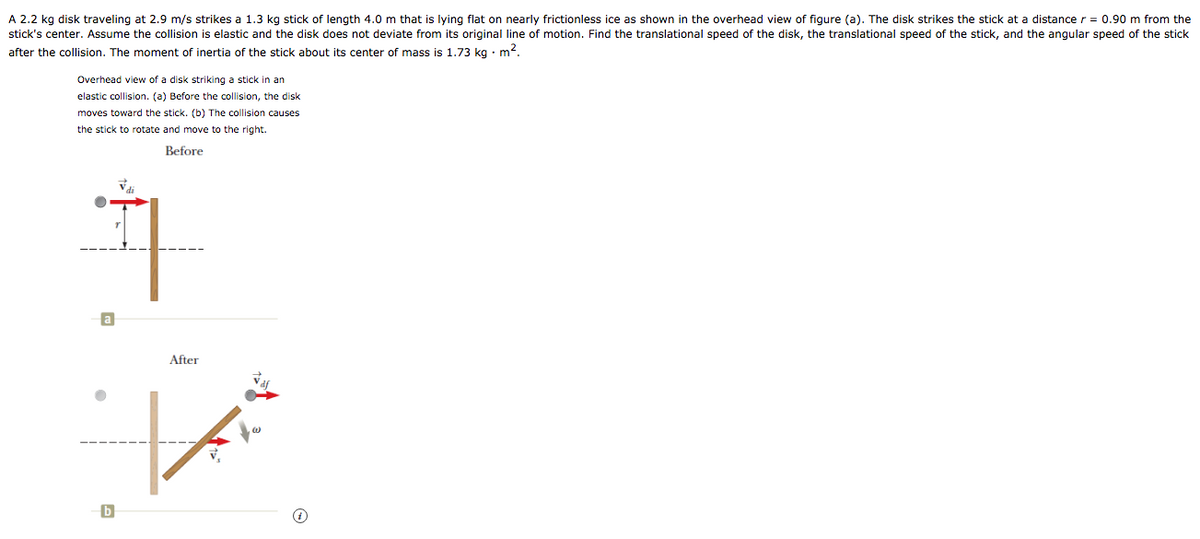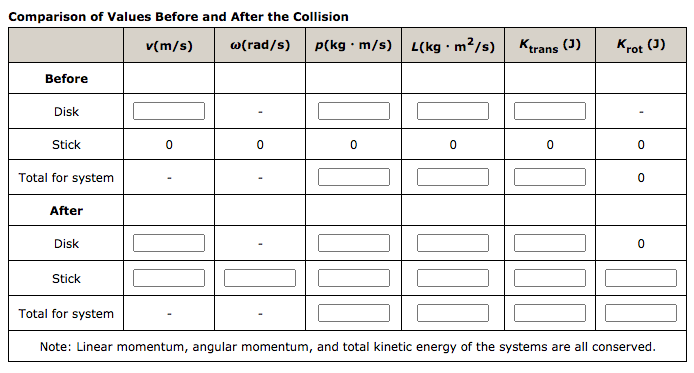A 2.2 kg disk traveling at 2.9 m/s strikes a 1.3 kg stick of length 4.0 m that is lying flat on nearly frictionless ice as shown in the overhead view of figure (a). disk strikes the stick at a distance r = 0.90 m from the stick's center. Assume the collision is elastic and the disk does not deviate from its original line of motion. Find the translational speed of the disk, the translational speed of the stick, and the angular speed of the stick after the collision. The moment of inertia of the stick about its center of mass is 1.73 kg · m². Overhead view of a disk striking a stick in an elastic collision. (a) Before the collision, the disk moves toward the stick. (b) The collision causes the stick rotate and move to the right. Before a After
A 2.2 kg disk traveling at 2.9 m/s strikes a 1.3 kg stick of length 4.0 m that is lying flat on nearly frictionless ice as shown in the overhead view of figure (a). disk strikes the stick at a distance r = 0.90 m from the stick's center. Assume the collision is elastic and the disk does not deviate from its original line of motion. Find the translational speed of the disk, the translational speed of the stick, and the angular speed of the stick after the collision. The moment of inertia of the stick about its center of mass is 1.73 kg · m². Overhead view of a disk striking a stick in an elastic collision. (a) Before the collision, the disk moves toward the stick. (b) The collision causes the stick rotate and move to the right. Before a After
Classical Dynamics of Particles and Systems
5th Edition
ISBN:9780534408961
Author:Stephen T. Thornton, Jerry B. Marion
Publisher:Stephen T. Thornton, Jerry B. Marion
Chapter9: Dynamics Of A System Of Particles
Section: Chapter Questions
Problem 9.23P
Related questions
Question

Transcribed Image Text:A 2.2 kg disk traveling at 2.9 m/s strikes a 1.3 kg stick of length 4.0 m that is lying flat on nearly frictionless ice as shown in the overhead view of figure (a). The disk strikes the stick at a distance r = 0.90 m from the
stick's center. Assume the collision is elastic and the disk does not deviate from its original line of motion. Find the translational speed of the disk, the translational speed of the stick, and the angular speed of the stick
after the collision. The moment of inertia of the stick about its center of mass is 1.73 kg • m2.
Overhead view of a disk striking a stick in an
elastic collision. (a) Before the collision, the disk
moves toward the stick. (b) The collision causes
the stick to rotate and move to the right.
Before
After
b

Transcribed Image Text:Comparison of Values Before and After the Collision
v(m/s)
w(rad/s)
p(kg · m/s)
L(kg · m²/s)
Ktrans (J)
Krot (J)
Before
Disk
Stick
Total for system
After
Disk
Stick
Total for system
Note: Linear momentum, angular momentum, and total kinetic energy of the systems are all conserved.
Expert Solution
This question has been solved!
Explore an expertly crafted, step-by-step solution for a thorough understanding of key concepts.
This is a popular solution!
Step 1: Given data
VIEWStep 2: Derivation of the expressions for the velocity and angular velocity after the collision
VIEWStep 3: Calculation of the velocity of the disk and stick after the collision
VIEWStep 4: Calculation of momentum of the system
VIEWStep 5: Calculation of the energy of the system and energy of each object.
VIEWSolution
VIEWTrending now
This is a popular solution!
Step by step
Solved in 6 steps with 8 images

Knowledge Booster
Learn more about
Need a deep-dive on the concept behind this application? Look no further. Learn more about this topic, physics and related others by exploring similar questions and additional content below.Recommended textbooks for you

Classical Dynamics of Particles and Systems
Physics
ISBN:
9780534408961
Author:
Stephen T. Thornton, Jerry B. Marion
Publisher:
Cengage Learning

Modern Physics
Physics
ISBN:
9781111794378
Author:
Raymond A. Serway, Clement J. Moses, Curt A. Moyer
Publisher:
Cengage Learning

Classical Dynamics of Particles and Systems
Physics
ISBN:
9780534408961
Author:
Stephen T. Thornton, Jerry B. Marion
Publisher:
Cengage Learning

Modern Physics
Physics
ISBN:
9781111794378
Author:
Raymond A. Serway, Clement J. Moses, Curt A. Moyer
Publisher:
Cengage Learning